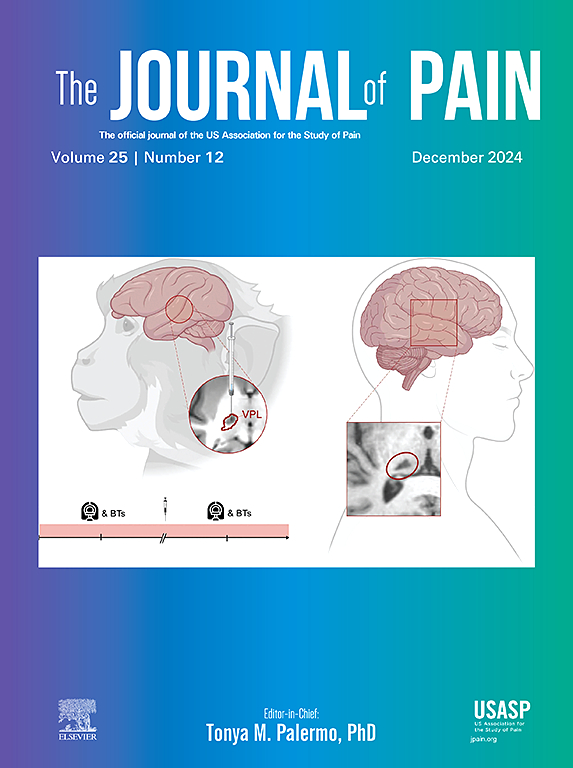Reduced functional resting-state connectivity in chronic pain patients with small fiber neuropathy
IF 4
2区 医学
Q1 CLINICAL NEUROLOGY
引用次数: 0
Abstract
Chronic neuropathic pain can lead to structural and functional brain reorganization. Neuropathic pain, the main symptom of small fiber neuropathy (SFN), may be linked to specific brain biosignatures. Functional connectivity changes during resting state (RS) have been observed in SFN patients, but little is known about these changes in idiopathic SFN. To explore this, we conducted RS-fMRI in 32 idiopathic SFN patients and 31 healthy controls (HC), focusing on the bilateral caudate nucleus (CN), where reduced gray matter volume (GMV) was previously reported. Functional connectivity analysis revealed that SFN patients had decreased connectivity between the right CN and the left supplementary motor area (SMA) compared to HC. This reduced connectivity correlated positively with both the patients’ total pain score (painDETECT) and the GMV of both caudate nuclei, suggesting that decreased RS connectivity is associated with lower GMV and higher pain levels. Exploratory subgroup analyses in patients with rare heterozygous missense variants in voltage-gated sodium channels (Nav) showed distinct connectivity patterns, highlighting potential genetic influences. Our findings suggest that brain functional changes during RS may be linked to a structural basis in chronic pain and might serve as neural signature for SFN patients. Further studies are needed to confirm these results and to investigate the role of genetic factors in SFN-related brain changes.
Perspective
This study identifies altered resting-state functional connectivity involving the caudate nucleus in idiopathic small fiber neuropathy patients, correlating with pain severity and structural changes. These findings may provide a neural signature for SFN, offering insights into chronic pain mechanisms. Future studies could explore genetic contributions, aiding clinical understanding and personalized treatment approaches.
伴有小纤维神经病的慢性疼痛患者的功能静息状态连通性降低。
慢性神经性疼痛可导致大脑结构和功能重组。神经性疼痛是小纤维神经病变(SFN)的主要症状,可能与特定的脑生物特征有关。在SFN患者中观察到静息状态(RS)时功能连通性的变化,但对特发性SFN患者的这些变化知之甚少。为了探讨这一点,我们对32名特发性SFN患者和31名健康对照(HC)进行了RS-fMRI检查,重点检查了双侧尾状核(CN),此前报道了该区域灰质体积(GMV)减少。功能连通性分析显示,与HC相比,SFN患者右侧CN和左侧辅助运动区(SMA)之间的连通性降低。这种连接减少与患者的总疼痛评分(painDETECT)和两个尾状核的GMV呈正相关,表明RS连接减少与较低的GMV和较高的疼痛水平相关。探索性亚组分析显示,电压门控钠通道(Nav)中罕见杂合错配变异的患者具有不同的连接模式,突出了潜在的遗传影响。我们的研究结果表明,RS期间的脑功能变化可能与慢性疼痛的结构基础有关,并可能作为SFN患者的神经特征。需要进一步的研究来证实这些结果,并调查遗传因素在sfn相关的大脑变化中的作用。
本文章由计算机程序翻译,如有差异,请以英文原文为准。
求助全文
约1分钟内获得全文
求助全文
来源期刊

Journal of Pain
医学-临床神经学
CiteScore
6.30
自引率
7.50%
发文量
441
审稿时长
42 days
期刊介绍:
The Journal of Pain publishes original articles related to all aspects of pain, including clinical and basic research, patient care, education, and health policy. Articles selected for publication in the Journal are most commonly reports of original clinical research or reports of original basic research. In addition, invited critical reviews, including meta analyses of drugs for pain management, invited commentaries on reviews, and exceptional case studies are published in the Journal. The mission of the Journal is to improve the care of patients in pain by providing a forum for clinical researchers, basic scientists, clinicians, and other health professionals to publish original research.
 求助内容:
求助内容: 应助结果提醒方式:
应助结果提醒方式:


